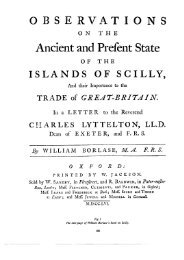Cornwall during the Iron Age and - Cornwall Archaeological Society
Cornwall during the Iron Age and - Cornwall Archaeological Society
Cornwall during the Iron Age and - Cornwall Archaeological Society
Create successful ePaper yourself
Turn your PDF publications into a flip-book with our unique Google optimized e-Paper software.
een occupied entirely within <strong>the</strong> Later <strong>Iron</strong> <strong>Age</strong> (Dudley, 1960; Schweiso, 1976). The plan<br />
shows dense occupation with timber houses in <strong>the</strong> centre as well as around <strong>the</strong> perimeter.<br />
The round at Trevisker, St Eval (ApSimon <strong>and</strong> Greenfield, 1972) was initially small,<br />
enclosing c. 0.1 ha with a timber round house 13 m across. Material on <strong>the</strong> floor of this house<br />
produced a radiocarbon date of 180 ± 90 bc (NPL —135). This phase was associated with<br />
South-Western Decorated pottery but was replaced, within <strong>the</strong> Later <strong>Iron</strong> <strong>Age</strong>, by a far larger<br />
enclosure of c. 1.2 ha <strong>and</strong> at least one large timber round house (Fig 2). Some occupation<br />
at Trevisker continued until <strong>the</strong> 2nd century AD. Castle Gotha round, near St Austell, also<br />
had a date range from <strong>the</strong> Later <strong>Iron</strong> <strong>Age</strong> until <strong>the</strong> 2nd, or possibly 3rd, century AD<br />
(Saunders <strong>and</strong> Harris, 1982).<br />
The <strong>Iron</strong> <strong>Age</strong> house plans so far recorded in <strong>Cornwall</strong> are circular, with an inner ring of<br />
posts taking <strong>the</strong> main weight of <strong>the</strong> roof, <strong>and</strong> an outer wall of granite blocks, shale, turf or<br />
timber depending on <strong>the</strong> locality. Stone-walled houses such as those at Bodrifty (Fig 2) are<br />
identical in plan to those found in <strong>the</strong> local Bronze <strong>Age</strong>, while <strong>the</strong> size of <strong>the</strong> houses at<br />
Trevisker is comparable with <strong>the</strong> largest found elsewhere in Sou<strong>the</strong>rn Britain. Reconstruction<br />
work by Reynolds on round houses of this size, using straw thatch, has shown in detail how<br />
<strong>the</strong>y might have looked (Reynolds, 1978; 1982).<br />
The relationship of a round to a field system was demonstrated at Goldherring, Sancreed<br />
(Guthrie, 1969). This round, built initially in <strong>the</strong> first century AD <strong>and</strong> containing smallish<br />
round houses, was set in a block of small rectangular fields. Fieldwork <strong>and</strong> <strong>the</strong> study of air<br />
photographs carried out since <strong>the</strong> late 1970s by <strong>the</strong> <strong>Cornwall</strong> <strong>Archaeological</strong> Unit (formerly<br />
<strong>Cornwall</strong> Committee for Rescue Archaeology) show traces of field systems regularly<br />
appearing around such sites, wherever conditions permit <strong>the</strong>ir survival (Johnson <strong>and</strong> Rose,<br />
1982; <strong>Cornwall</strong> Committee for Rescue Archaeology Reports 1977 onward). The full implications<br />
of this fieldwork, which is still continuing, have yet to be assessed. Fields indicate<br />
arable farming. Evidence for specific cereal production is sparse, because no proper wet<br />
sieving <strong>and</strong> analysis programme has yet been carried out. Hordeum spp. (barley), Avena spp.<br />
(wild or cultivated oats) <strong>and</strong> Secale cereale (rye) were recorded at Goldherring (Guthrie,<br />
1969, 38), Triticum dicoccum (emmer), T. spelta (spelt) <strong>and</strong> Avena sp. at Killibury<br />
(Hillman, G. in Miles et al, 1977). Pollen analysis suggested arable farming around Cam<br />
Euny, where traces of fields survive around <strong>the</strong> unenclosed settlement (Christie, 1978, 311,<br />
426). Querns are found on all types of settlement site. Rotary querns were introduced into<br />
<strong>Cornwall</strong> in <strong>the</strong> Later <strong>Iron</strong> <strong>Age</strong>, as in to <strong>the</strong> remainder of Britain (eg Trevisker, ApSimon<br />
<strong>and</strong> Greenfield, 1972, 349) but .,addle querns continued to be used as well, <strong>and</strong> both types<br />
are found throughout <strong>the</strong> Roman period. Detailed underst<strong>and</strong>ing of settlement patterns <strong>and</strong><br />
farming practices awaits fur<strong>the</strong>r work on macroscopic plant remains <strong>and</strong> pollen analysis. It<br />
must also depend on more detailed knowledge of <strong>the</strong> relationship of rounds <strong>and</strong> hillforts to<br />
<strong>the</strong> unenclosed settlements, which remain elusive throughout <strong>the</strong> <strong>Iron</strong> <strong>Age</strong>. That at Cam Euny<br />
was located because it underlay a later settlement of courtyard houses.<br />
The variations in enclosed <strong>and</strong> fortified sites presented by Johnson <strong>and</strong> Rose (1982)<br />
indicate complex social patterns varying through time. The rounds have been seen as <strong>the</strong><br />
settlements of l<strong>and</strong>owning kindred groups (Fox, 1964, 125). Multiple enclosure hillforts<br />
should represent an upper social stratum of chiefs. The extent of defences on some larger<br />
sites indicates control of considerable man power. Cattle have been seen as <strong>the</strong> basis of wealth<br />
for <strong>the</strong>se chiefs, but sheep, better suited to South Western upl<strong>and</strong> grazing, should also be considered<br />
as an important local resource. Grazing for ei<strong>the</strong>r implies considerable tracts of l<strong>and</strong><br />
controlled from multiple enclosure hillforts. Ano<strong>the</strong>r possibility would be areas of arable<br />
worked by bondmen, a system foreshadowing <strong>the</strong> l<strong>and</strong>holding system of Early Medieval<br />
Wales. The occupants of rounds may have paid dues in kind or labour. It is probable that<br />
117




